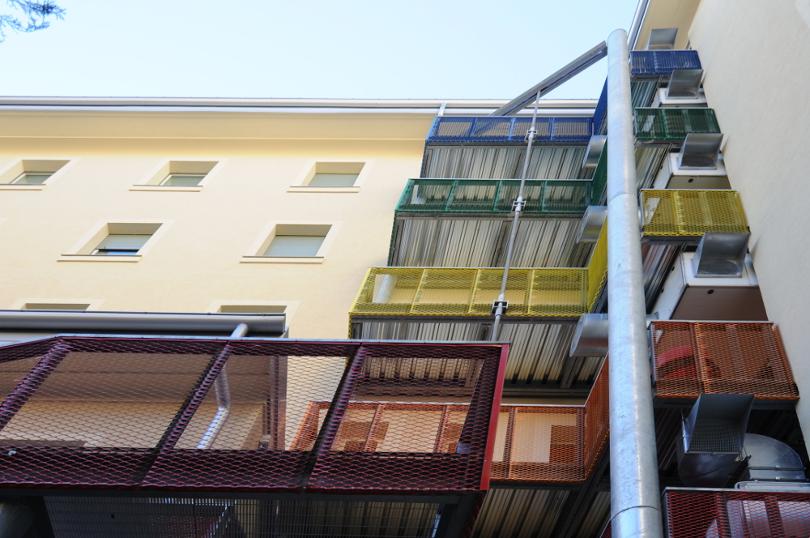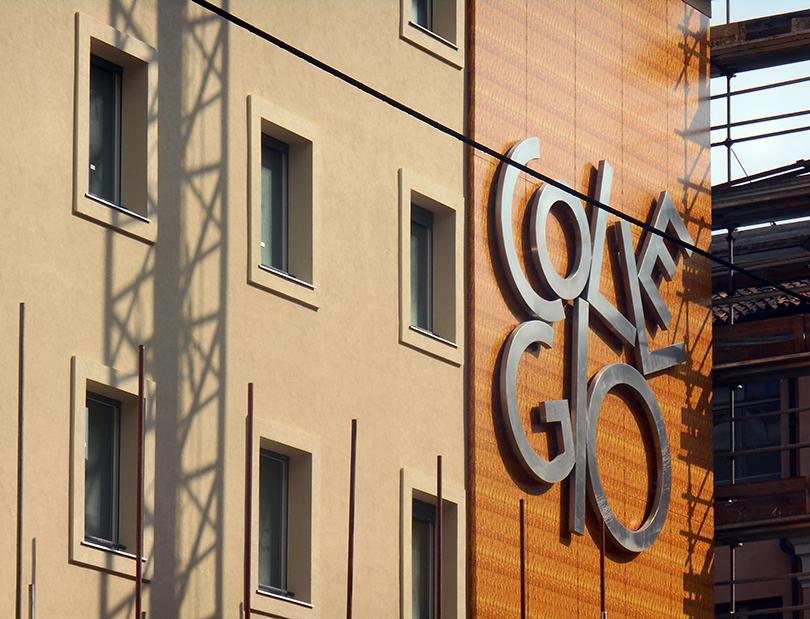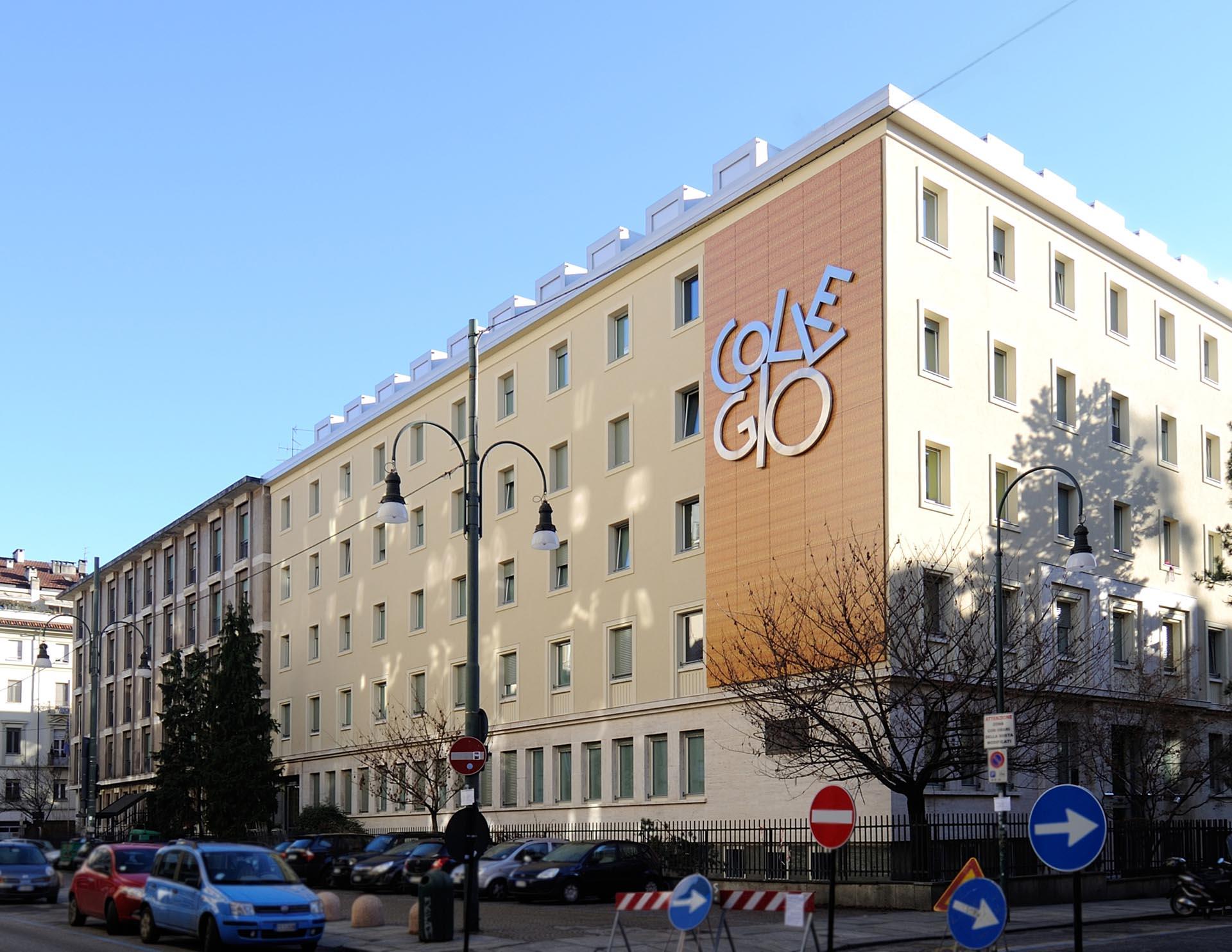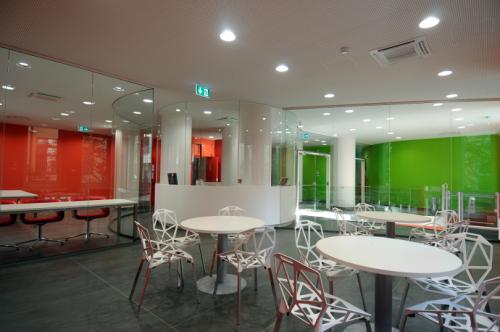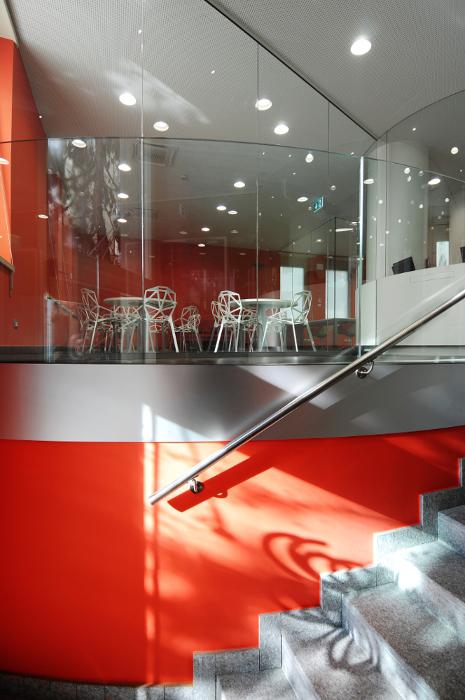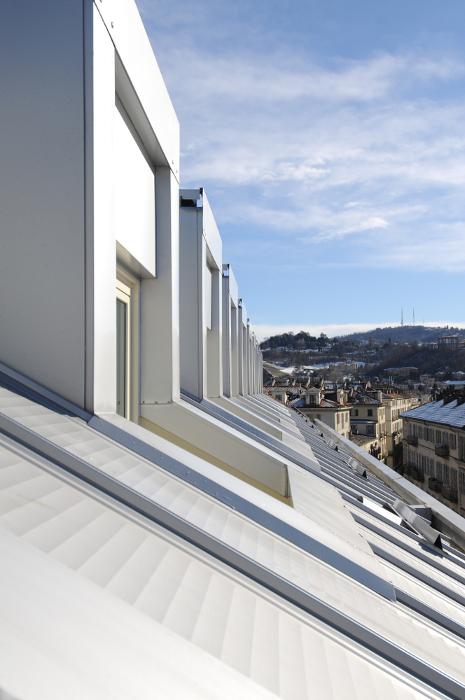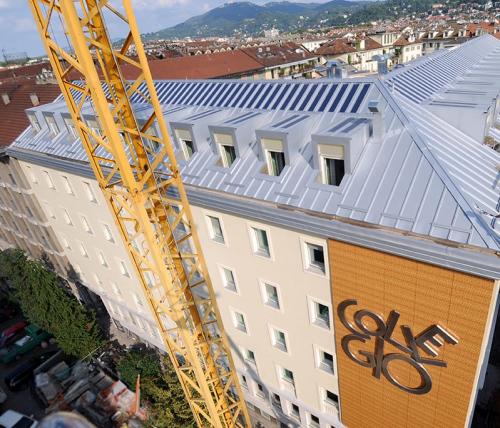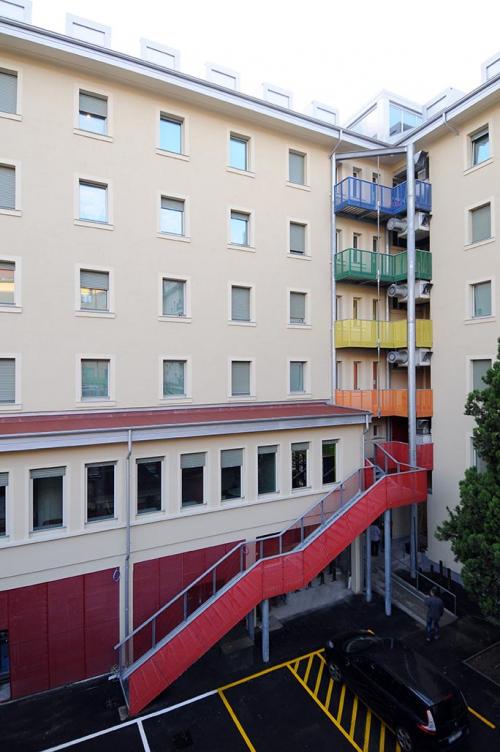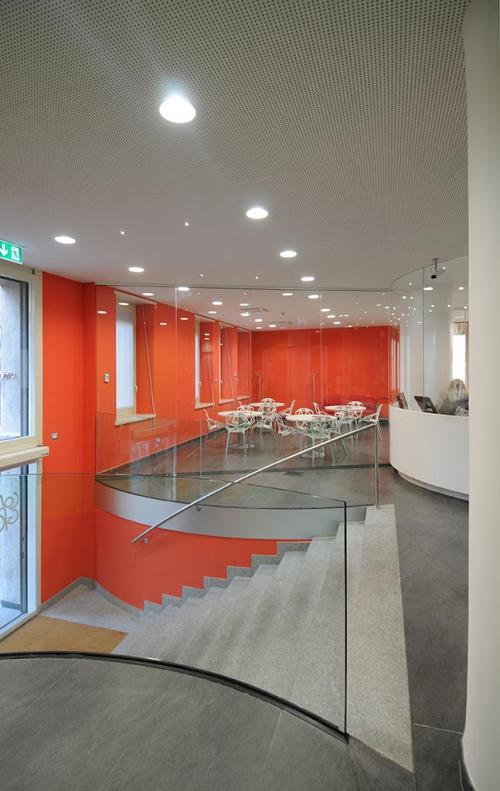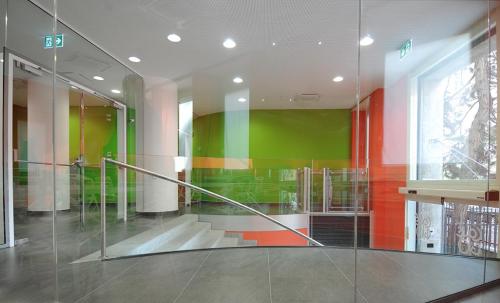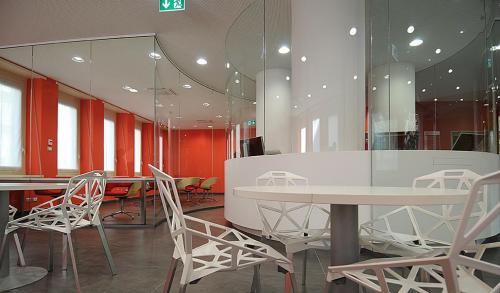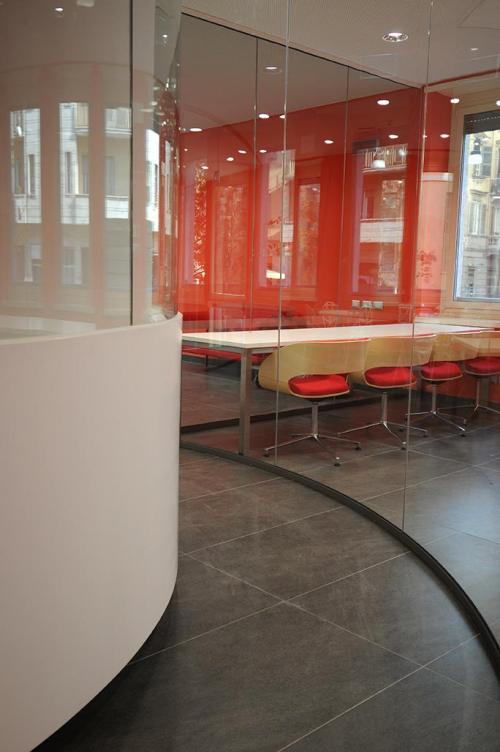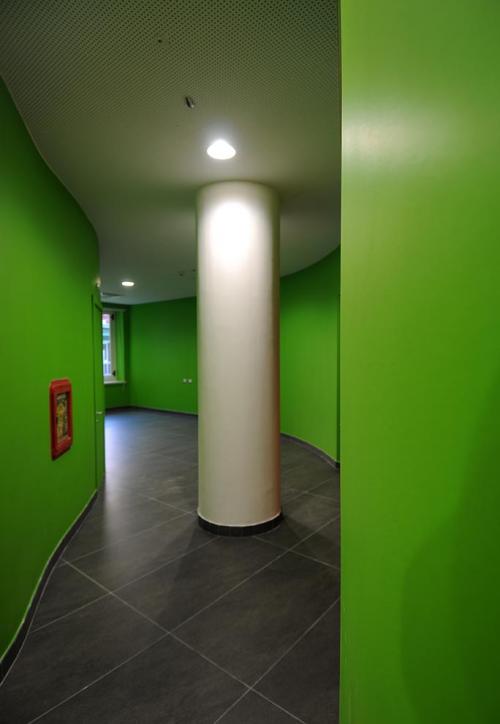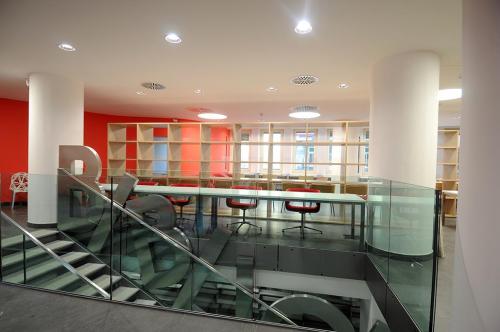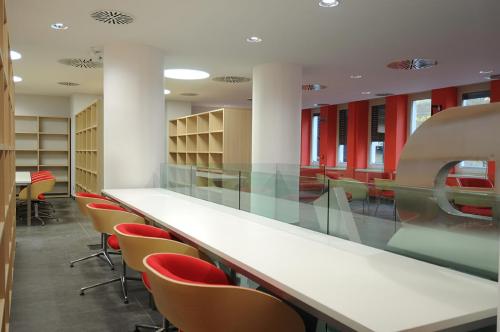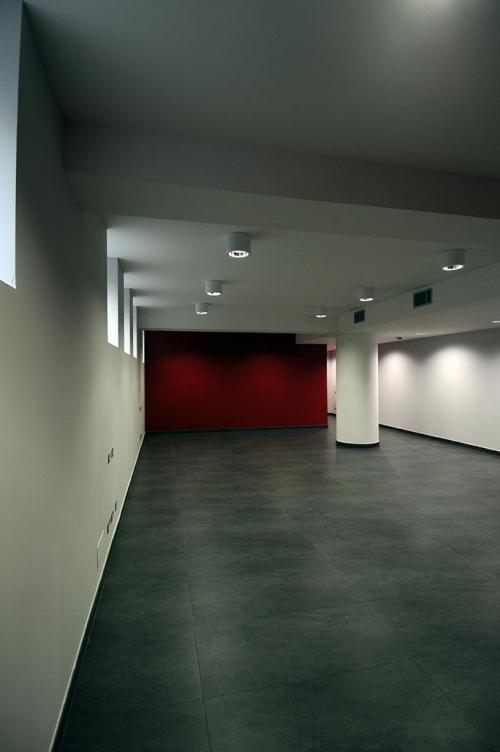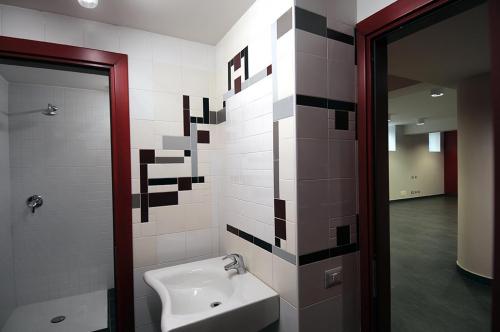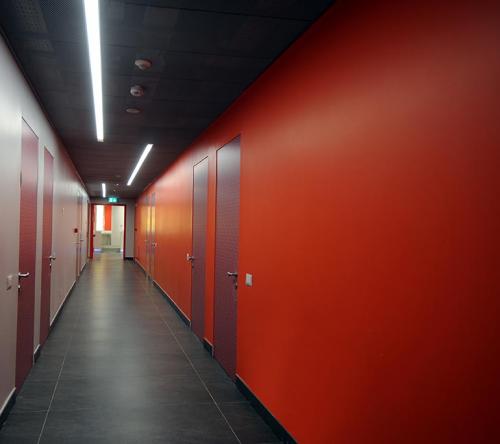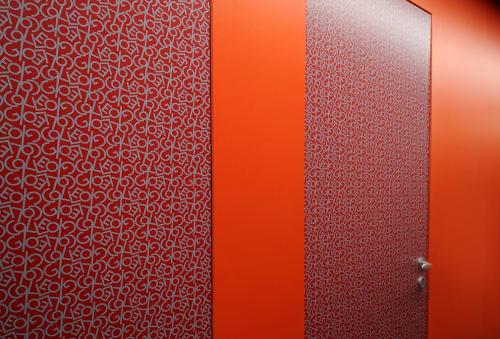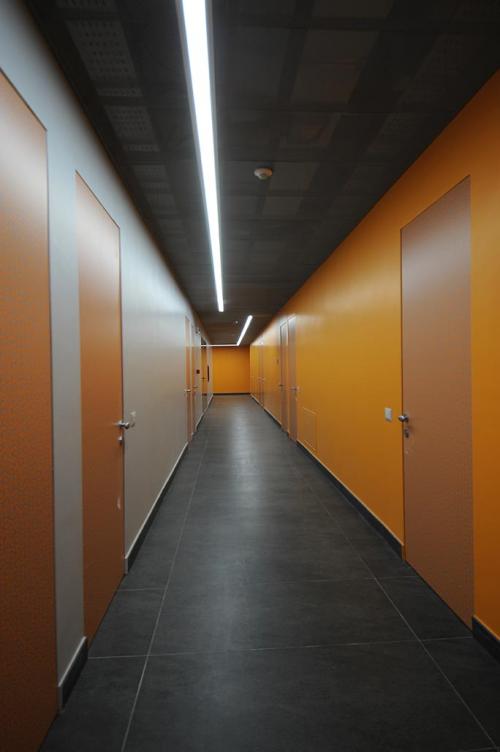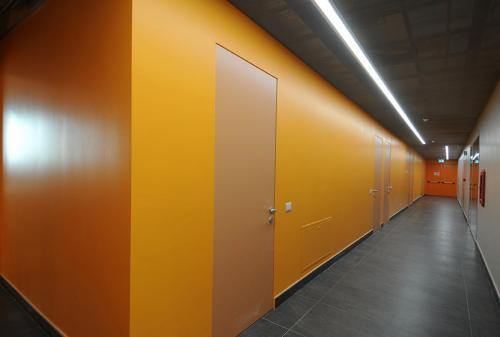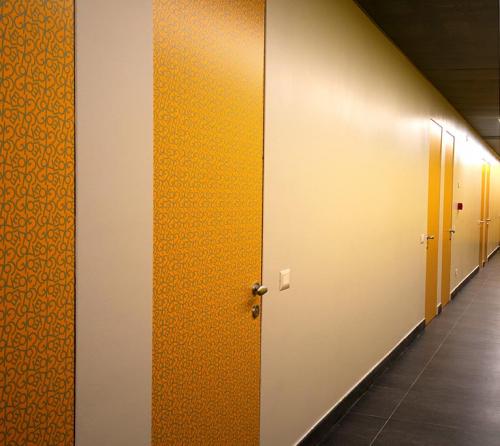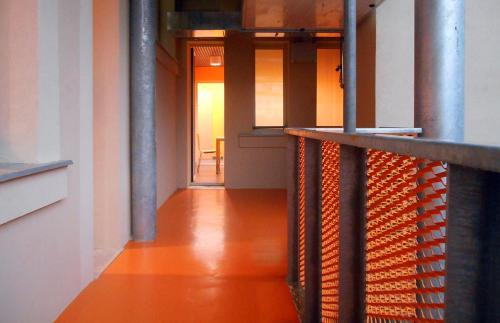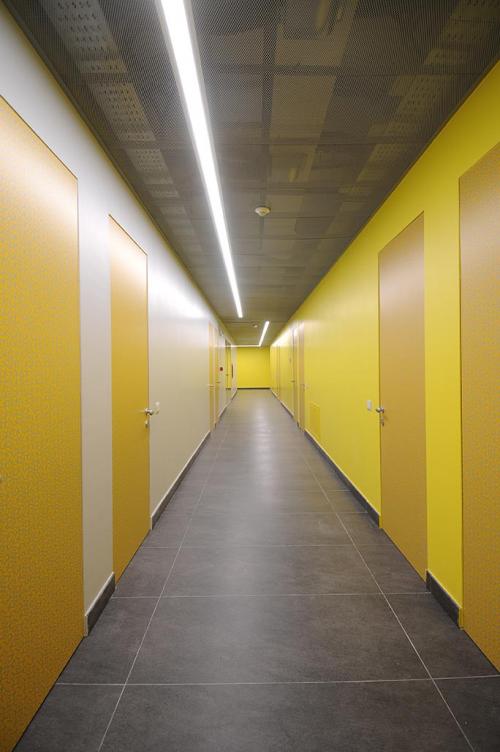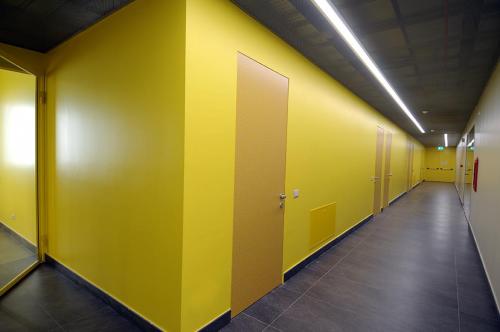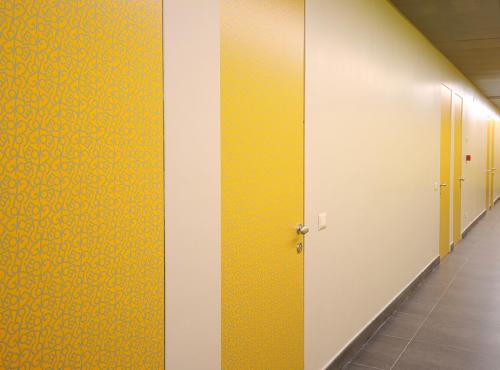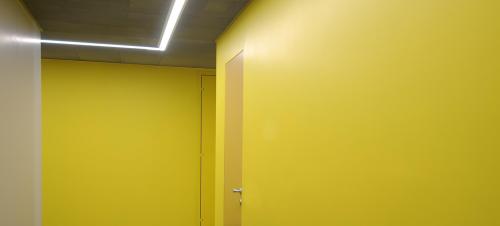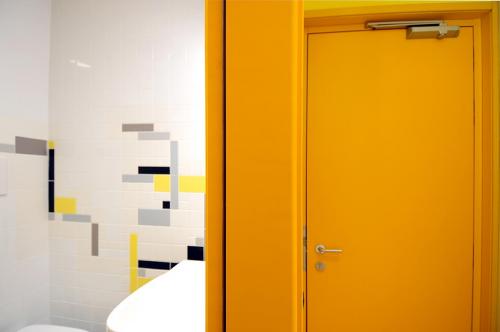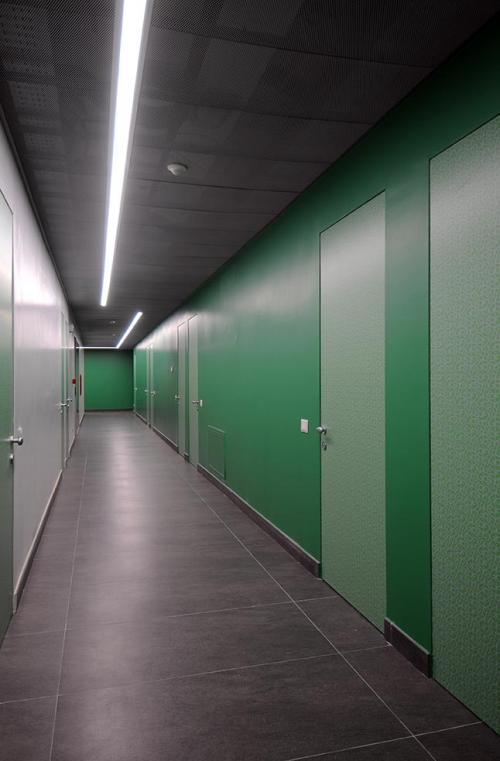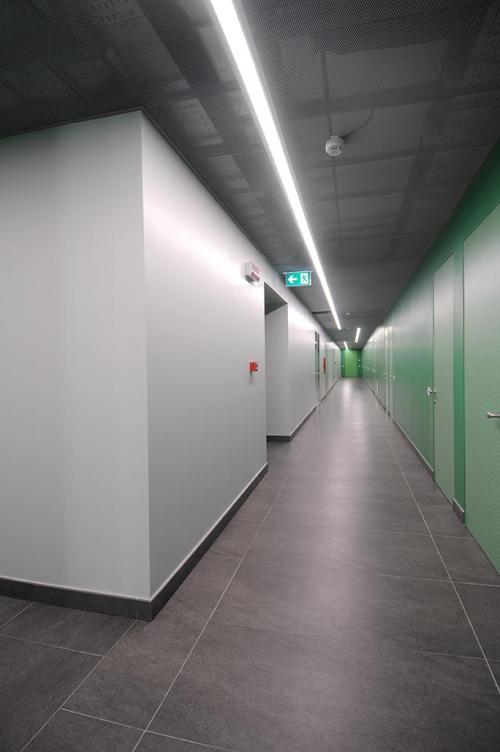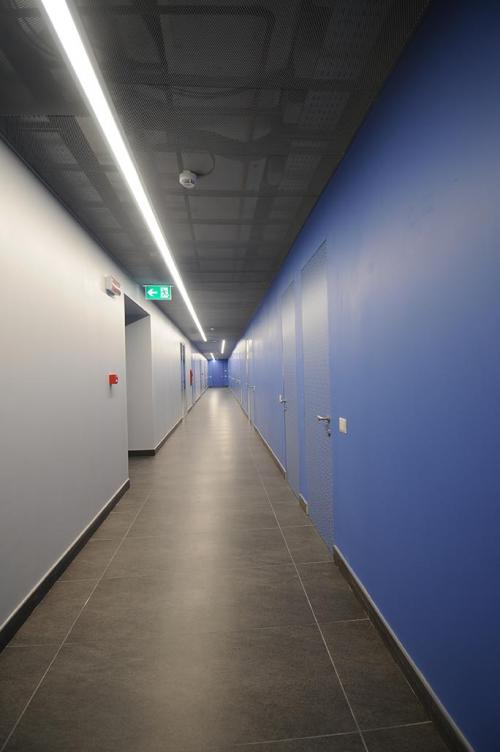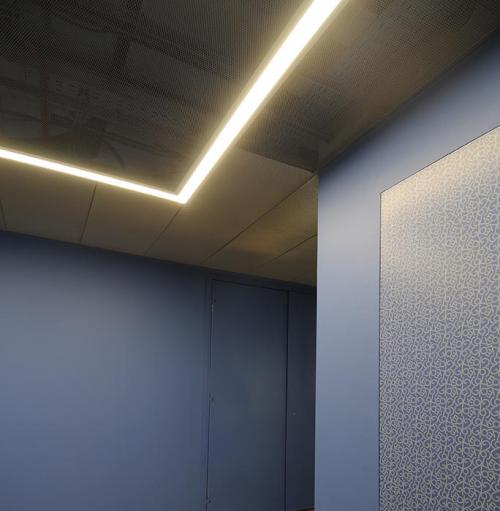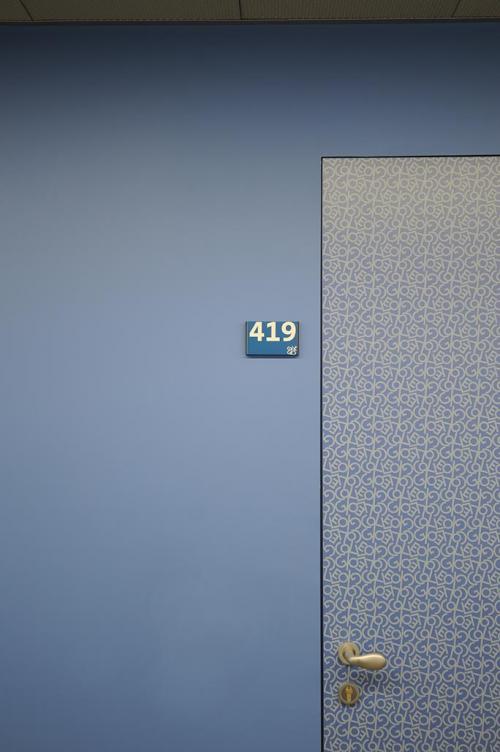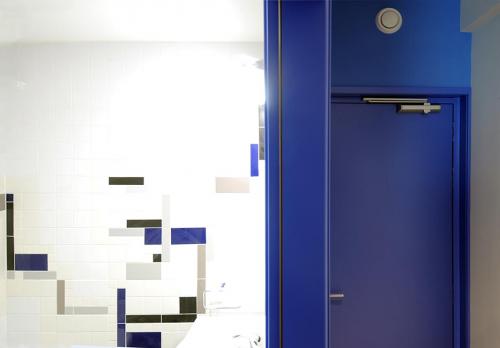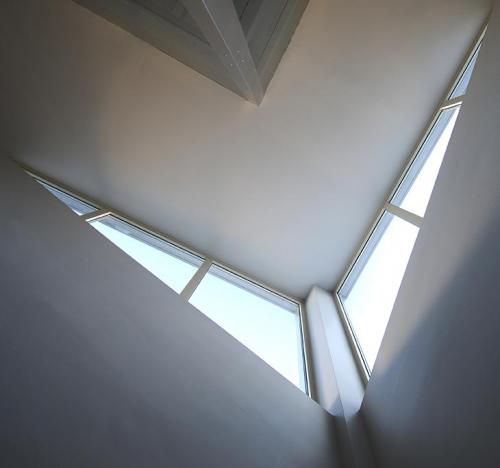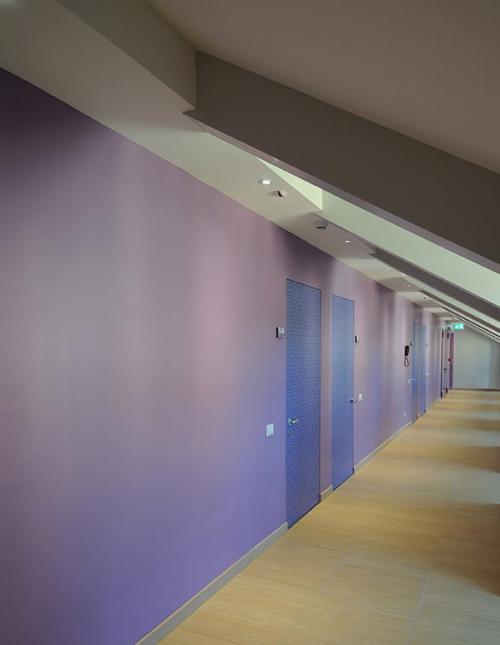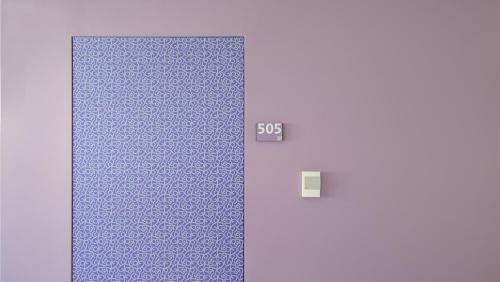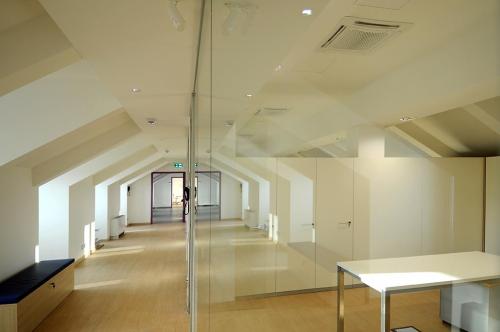architecture
Collegio Po - Torino
Ristrutturazione collegio universitario "Po" - Einaudi
cronologia: 2011-2015
Finalista The Plan Award 2015
Certificato LEED livello Gold
1 Cronaca storica
Tra il 2011 ed il 2015 mi sono occupato della ristrutturazione della Sezione Po (l’ex sezione femminile) del Collegio Universitario di Torino Renato Einaudi. L’edificio sorge nella parte del centro storico di Torino che si è formata con l’ampliamento curato da Amedeo di Castellamonte (1673), la cosiddetta “Città Nuova di Po”, appena dentro le mura, subito a ridosso dell’esedra della futura piazza Vittorio Veneto. Nel Plan démonstratif di Giacomo Pregliasco del 1802 (alla luce del decreto napoleonico del 23 giugno 1800 di disarmo delle fortificazioni), per la riconversione delle aree delle mura, l’isolato sul qual sorge il nostro edificio è ben leggibile nell’espansione castellamontiana di colore turchese. Anche nel Plan démonstratif di Ferdinando Bonsignore del 1805 circa, codesto isolato è ben leggibile nell’espansione castellamontiana di colore azzurro. Nel disegno di Bonsignore si può ancora rilevare, in tratteggio, il sedime delle mura verso il Po. Del 1817 è il piano di ampliamento della città a cura di Gaetano Lombardi con il contributo di Michelotti, Cardone, Bonsignore e Brunati. Sempre del 1817 è l’approvazione del “Piano regolare della città di Torino e Sobborghi” di Gaetano Lombardi. Un passo indietro. Una pianta della città di Torino del 1790 (conservata nell’Archivio Storico comunale), con il tracciato delle fortificazioni e la cittadella, ci permette di rilevare la destinazione del tempo del fabbricato che insisteva sull’isola di San Valerio, tra la contrada del Soccorso e quella delle Rosine, nell’area del collegio: si trattava dei magazzini reali del grano, il Reggio Magazeno delle Grani. All’Archivio di Stato di Torino, in merito ai magazzini del grano, sono conservati due disegni: una pianta ed una sezione, sebbene con poche affinità con lo schema di cui alla pianta geometrica della città. In una pianta della città di Torino di metà Ottocento la conformazione delle aree verso il Po ha già assunto il disegno a noi familiare. I magazzini dei grani e dei panni sono sostituiti dalle caserme, tra le quali – sull’attuale via Principe Amedeo - la Caserma Ceppi, dalla quale il 1^ luglio 1836 uscirono per la prima volta i Bersaglieri (corpo militare creato dal generale Alessandro Ferrero della Marmora, costituitosi a Torino con atto del 18 giugno 1836). Per la sezione Po, al posto dei magazzini del grano, si registra la presenza – sino alla II Guerra Mondiale - del Battaglione aviatori, istituito - nell'ambito del Ministero della Guerra, attraverso un Ufficio d'ispezione dei servizi aeronautici - con Legge 27 giugno 1912 n. 698. Nel secondo dopoguerra prende avvio, sul sedime delle caserme, la realizzazione prima della Sezione Po ed in seguito della Sezione Mole. Della Sezione Po firma il progetto (maggio / luglio 1953) l’architetto Giulio Momo, unitamente all’ingegnere Augusto Momo. Il 31 dicembre 1953 il Comune di Torino autorizza la costruzione. I lavori vengono eseguiti sotto la direzione dell’architetto Giulio Momo e la vigilanza del capomastro ing. Erberto Olivero. Per tutto il secondo Novecento la Sezione Po è quella destinata alle studentesse: è la cosiddetta sezione femminile del Collegio Einaudi. Dopo il primo decennio del XXI secolo la struttura si presenta inadeguata ai nuovi standard di accoglienza per studenti. Quando il MIUR emana il bando per l’assegnazione di fondi per la riqualificazione delle residenze universitarie il Collegio Einaudi partecipa con il mio progetto di riqualificazione e vince subito l’assegnazione delle risorse. Durante l’anno accademico 2013/2014 avvengono i lavori di ristrutturazione. L’edificio si presenta ora rinnovato sia dal punto di vista funzionale che impiantistico, e sostenibile sul fronte ecologico. Il processo di costruzione - il cantiere - e l’edificio ultimato sono certificati secondo il protocollo Leed.
2 La nuova vita della fabbrica
Da magazzino regio del grano a caserma sino a collegio. Siamo alla terza vita funzionale (in base agli elementi raccolti) della fabbrica sorta all’angolo di via Maria Vittoria con Via delle Rosine. O meglio, considerato che la ristrutturazione della quale mi sono occupato è stata in realtà intensa, dura, sostanziale, possiamo parlare di quarta vita della fabbrica. Prima erano campi, tra le mura della città ed il fiume, un po’ in discesa, prima del borgo di pescatori nei pressi del ponte. Della costruzione originaria si è conservato ben poco: la struttura portante è stata consolidata; l’involucro murario è stato “cappottato”; i serramenti sono stati sostituiti; la copertura è stata rifatta, recuperando il sottotetto per camere ed uffici. Gli impianti sono stati rifatti completamente, e comprendono un sistema a pannelli solari per la produzione di acqua calda sanitaria, pannelli fotovoltaici per la produzione di energia elettrica, un impianto geotermico per lo sfruttamento dell’acqua di falda per il riscaldamento ed il raffrescamento dell’edificio. Tutti gli ambienti sono cablati e controllati da un sistema di supervisione BMS (Building Management System), che permette da remoto di regolare gli impianti elettrici e meccanici. Gli accessi alla struttura avvengono per mezzo di badge, così come per l’attivazione dell’impianto di illuminazione delle camere. L’obbiettivo da raggiungere era in sostanza riqualificare un edificio non più adeguato alla sua funzione, nel rispetto dei nuovi criteri ministeriali di cui agli “Standard minimi qualitativi e linee guida relative ai parametri tecnici ed economici”, raggiungendo la certificazione internazionale del livello di sostenibilità energetico – ambientale degli edifici secondo la procedura LEED (Leadership in Energy and Environmental Design) sviluppata dall’US Green Building Council (USGBC), con un approccio etico ed emozionale. L’edificio in sé conteneva già degli elementi di sostenibilità legati alla sua posizione, alla vicinanza ai servizi e al fatto di essere un edificio esistente per il quale non era necessaria una demolizione e ricostruzione ma un riuso. Gli interventi edilizi realizzati ai fini della sostenibilità sono stati principalmente: l’isolamento a cappotto dell’edificio (rivestimento integrale comprendente davanzali, cornicioni e cornici); la sostituzione dei serramenti (con profili a taglio termico e vetri a doppia camera basso emissivi); il rifacimento della copertura con elevata riflessione solare (alluminio); l’utilizzo di materiali basso emissivi (adesivi, primer, sigillanti, materiali, cementizi e finiture per legno, pitture); l’utilizzo di materiali con contenuto di riciclato (vetri, alluminio, etc.); l’utilizzo di materiali estratti, lavorati e prodotti a distanza limitata (p.es. pietre e laterizi); la massimizzazione degli spazi con visuale diretta verso l’esterno. Gli interventi impiantistici realizzati ai fini della sostenibilità sono stati: l’utilizzo di apparecchiature sanitarie a basso consumo per massimizzare la riduzione dell’uso dell’acqua (miscelatori con limitatori di portata, cassette di cacciata a tre tipi di funzionamento…); l’utilizzo di pompa di calore geotermica associata a pannelli radianti e di sistemi di recupero del calore dell’aria per la massimizzazione dell’efficienza impiantistica a beneficio dell’ottimizzazione delle prestazioni energetiche e del comfort termico delle persone (potenzialità termica 300 kW, frigorifera 250 kW, portata pozzi da 15 a 30 l/s); l’installazione di collettori solari per la produzione dell’acqua calda ad uso sanitario (collettori ad elevata efficienza con piastra captante in rame, per un totale di ca. 80 mq); l’installazione di pannelli fotovoltaici per la produzione di energia elettrica (laminato flessibile applicato sulla copertura per una potenza di picco di circa 20 kW); la corretta ventilazione degli ambienti secondo norme UNI EN 15251 e UNI EN 13779; sistemi di controllo e regolazione individuale dell’illuminazione da parte degli occupanti; sistemi di controllo e regolazione individuale del comfort termico da parte degli occupanti. Durante l’attività di costruzione sono state attuate azioni ai fini della sostenibilità: sviluppo di un piano di controllo dell’erosione e della sedimentazione (PCES) per tutte le attività costruttive che consenta di evitare la perdita di terreno durante la fase di costruzione dato da pioggia o vento, di prevenire la sedimentazione nel sistema fognario di raccolta delle acque, e di evitare di inquinare l’aria con polveri o particolati; la gestione dei rifiuti da costruzione in modo da deviare gli stessi dal conferimento in discarica per oltre il 75%, documentato attraverso un piano di gestione dei rifiuti; l’utilizzo di apparecchiature sanitarie a basso consumo per massimizzare la riduzione dell’uso dell’acqua. Per la realizzazione della nuova centrale tecnologica ipogea è stato necessario posare una serie di micropali a passo ravvicinato, mentre per la formazione dei pozzi dell’impianto geotermico è stata impiegata una macchina perforatrice con trivella di grande diametro. Dal piano strada i pozzi raggiungono la profondità di circa venti metri, lunghe cannucce per sfruttare la temperatura dell’acqua ctonia di falda. Durante la fase di costruzione è stato infine realizzato un programma di educational program sul cantiere in modo da informare e sensibilizzare gli studenti, ospiti dei collegi Einaudi, sui principi e applicazioni della sostenibilità nella riqualificazione edilizia. Particolare attenzione è stata posta alle tematiche acustiche onde assicurare un elevato livello di comfort agli utenti. Per quanto concerne le strutture, le verifiche statiche di portata e la nuova normativa sismica hanno comportato la necessità di consolidare i pilastri e le travi. Sono stati impiegati l’acciaio e le fibre di carbonio.
3 Aspetti dell’architettura
La trasparenza ed il colore sono stati alcuni degli ingredienti del progetto di riqualificazione/trasformazione. All’ingresso le pareti sono diventate di vetro, a tutt’altezza, così come quelle ai piani delle cucine e delle sale studio. Vi è continuità visiva tra un ambiente e l’altro. La reception è stata spostata e resa più baricentrica alla hall, potendo così agevolmente controllare gli accessi e gli ambienti comuni al piano. Il bancone è stato realizzato con pareti curve di cristallo su una base in corian bianco. Il colore caratterizza/comunica i piani; dall’infrarosso del piano seminterrato (che per me è il rosso barolo), sino all’ultravioletto del sottotetto, passando per il rosso, l’arancione, il giallo, il verde ed il blu, secondo lo spettro dei colori. Il colore – di “riferimento” – dei piani è stato applicato su alcune pareti delle camere, su quelle degli spazi comuni, sui laminati delle porte e dei mobili, su alcune piastrelle dei rivestimenti dei bagni, sulle resine a pavimento dei ballatoi ed ivi sui parapetti. Tra i materiali impiegati, per comunicare ho scelto l’acciaio inox, con il quale sono realizzate in esterno la scritta-logo collegio, ed all’interno la grande scritta “BIBLIOTECA” che accompagna la scala interna della biblioteca, realizzata per mettere in comunicazione il piano rialzato – dedicato alla lettura - con i depositi dei libri del piano seminterrato. I parapetti della scala sono in vetro: non vi è soluzione di continuità tra i due piani della biblioteca. In esterno, per ricordare l’antica destinazione a magazzini del grano, una pannellatura in alucobond serigrafato riporta la texture di un campo di grano. Il colore giallo della texture è coordinato con i nuovi colori della facciata (Per gli studi iniziali ho impiegato fotografie di campi di grano del Canavese, mentre per la texture finale ho utilizzato le fotografie di un campo del Monferrato nei pressi di Vignale, comune che ho frequentato per molti anni per la direzione dei lavori di restauro di Palazzo Callori. Un’impresa di Torino ha installato i pannelli sandwich provenienti da Milano, stampati a Berlino (dove era disponibile una tecnologia che garantiva una maggior durata dei pigmenti). Con il recupero del sottotetto ho introdotto nella copertura una quadrupla teoria di abbaini, di forma squadrata, lineare, dotati di piccoli balconi che permettono di affacciarsi lungo le quattro direzioni cardinali. Anche le pareti dei nuovi uffici, spostati dal piano rialzato al sottotetto, sono vetrate a tutt’altezza. Gli ambienti risultano molto luminosi, potendo contare su luce naturale proveniente contemporaneamente da nord e da sud. Le linee sono essenziali, minimaliste. La distribuzione dei locali, la successione delle stanze sono razionali. I materiali sono “elementari”, come le finiture: i pavimenti sono di pietra di Luserna fiammata nelle scale e di grés fine porcellanato naturale nei corridoi, nelle camere e nei locali comuni; cambiano i formati ed i colori. Il disegno più complesso è quello dei rivestimenti dei bagni in monocottura, per i quali sono stati impiegati cinque formati in più colori, in combinazione con quelli di riferimento dei piani. Nel collegio sono disponibili ambienti per la vita collettiva e locali privati; nell’insieme gli spazi sono accoglienti e nel contempo permettono vita di relazione sociale o concentrazione/silenzio per lo studio, secondo le esigenze personali. Nella camera, singola, con bagno, lo studente può disvelare la propria natura, manifestare la propria identità, consolidare la propria appartenenza; è nella sequenza pelle, abito, casa, la “terza pelle”. Anche per questa riqualificazione le scelte progettuali sono state guidate dalla “necessità” di ridare dignità all’atto dell’abitare; abitare che, Heideggerianamente, “è il tratto fondamentale dell’essere in conformità del quale i mortali sono” (Cfr. Martin Heidegger, “Costruire, abitare, pensare”, in Gaetano Chiurazzi, Il postmoderno, Bruno Mondadori, Milano 2002). Per lo studente la sua camera nel collegio di fatto surroga temporaneamente la “casa”; deve pertanto possederne delle “qualità”. Una casa che però non guarda al “passato”, non è museo/deposito di ricordi e feticci, ma lo accompagna nel “futuro” della vita matura, “rassicurandolo”, facendogli sentire di meno la distanza dalla famiglia. La camera è quindi spazio-teatro per la rappresentazione di azioni quali: dormire, studiare, rilassarsi, pensare, socializzare, amare…, ovvero “vivere”. Vivere in una comunità, un “campus” ante-litteram, dove “realizzarzi” come uomini prima ancora, o non solo, che come studenti.
APERTA PARENTESI. Mentre scrivo ho in mano una copia del domenicale del 25 gennaio 2015 (l’inserto Domenica de Il Sole 24 Ore, n. 24 del 25 gennaio 2015. I brani citati nella parentesi sono estratti da: D. Scarpa, “La memoria chimica di Levi”, p. 23; E. Di Caro, “Un campus all’americana. Nell’Artico”, p.24; A. Massarenti, “Maestra del nostro tempo”, p. 25; Y. Bonnefoy, “Quanti ricordi dentro un baule”, p. 25; C. Battocletti, “La Resistenza nel golfo”, p. 26; R. Casati e A. Varzi, “Gli occhiali giusti”, p. 28; D. Cianci, “Il diritto di pensare”, p. 29; S. Salis, “Tutto il tempo in una stanza”, p. 34; M. Bona Castellotti, “Quel genio di Bramante arrivò in Lombardia”, e G. Beltramini, “Quando Donato disegnò S. Pietro”, p. 36; “Lezioni a Genova”, p.37; A. Pascale, “Quando l’io perde pezzi”, p. 39; P. Mastrocola, “Pagelle e pedoni tra le nuvole”, p. 40). Mi soffermo su alcune parole e le loro possibili relazioni col collegio. Della prima pagina mi colpisce il titolo: “La memoria chimica di Levi” ed i correlati articoli per i settant’anni dalla liberazione di Auschwitz. Il collegio è sorto sul sedime di una caserma, subito dopo la fine della Seconda Guerra Mondiale. Quante vite. Nuovo destino e nuove speranze con il nuovo edificio. Della seconda pagina rilevo: “Un campus all’americana.” In una cittadina vicino a Capo Nord, nell’Artico, “hanno puntato moltissimo sulla ricerca e l’innovazione, con un’offerta ricca e una cura dello studente sin dal suo arrivo”. E’ un po’ quello che succede all’Einaudi. Un microcampus nella città che si prende cura degli studenti da subito, e non li abbandona neanche dopo l’ultimazione degli studi. Della terza pagina sottolineo: “La buona scuola (…) più logica, pensiero critico, esperienze reali e immaginazione”. Dove anche secondo Aristotele l’apprendimento deve “essere accompagnato da “esperienze” di vita capaci di dare un senso ai saperi per esseri umani, non per eruditi”. Questi “elementi” sono coltivati ed alimentati dal vivere nel collegio. Dal fondo pagina riprendo un testo di Yves Bonnefoy: “Faccio ritorno nella casa di un passato (…) lontano. Ed è grande il mio stupore quando scopro che le stanze sono più grandi di come le ricordavo, a cominciare dalla scala che era il ricordo più nitido. (…) Ma non ricordavo che i gradini fossero così larghi e bassi, di pietra massiccia, grigia, né che proseguissero con quella maestosità fino alla soffitta, per quanto ci andassi di continuo, a leggere.” Dalla quarta pagina, l’“auscultazione della propria identità anche attraverso il luogo delle origini”. La nostra identità non può prescindere dal luogo d’origine ma la formazione attraverso l’esperienza collegiale la fa maturare nel modo migliore e la arricchisce, la completa. Della sesta pagina mi soffermo sulle semplicità insormontabili di Casati e Varzi: “la cosa importante, per un filosofo, non è pulire le lenti così come non è inforcare gli occhiali. La cosa importante – e difficile – è costruire gli occhiali giusti”. Lascio a Voi estrarre il senso della metafora. Se “Il diritto di pensare” è un titolo della settima pagina, nella dodicesima fondamentale per me è “Tutto il tempo in una stanza”, dedicato a “Here” di Richard Mc Guire, che ha assunto un solo punto di vista nello scorrere del tempo: un angolo interno di una stanza. Quanti ricordi, quanti sogni mi tornano in mente dal punto di vista privilegiato fisso e nel contempo mobile, sdraiato sul letto della camera, rivolto alla congiunzione delle pareti col soffitto. Mc Guire si sofferma, in un dato luogo, sullo “scorrere del tempo: l’intuizione dell’autore è quella di aprire delle “finestre” (ambiente tipico delle nostre interazioni quotidiane) all’interno della tavola. (…) Che so: in quel punto della casa oggi si beve un bicchiere d’acqua, anni fa capitava un abbraccio (…)”. Quante storie si potrebbero narrare. Ed ancora, nella quattordicesima pagina ritrovo l’amato Bramante, dove “la massa muraria è trasformata in retorica, in quinta scenografica”, e dove un “disegno di architettura ci consente di fare non solo la storia dei vincitori, gli edifici costruiti, ma anche delle soluzioni mai realizzate”. Nel nostro caso la retorica non c’è. I muri rappresentano quello che sono e delimitano effettivamente lo spazio ove il corpo può agire, mentre lo sguardo talvolta va oltre; con i cristalli i muri perdono alcuni limiti fisici, decontestualizzano e per certi versi dematerializzano l’esperienza. Con la quindicesima ci ricordiamo di riscoprire “il piacere di imparare divertendosi”, mentre nella diciassettesima emerge un’evidenza delle neuroscienze: “abbiamo bisogno delle emozioni per accendere il ragionamento (e anche il contrario, le emozioni possono causare bias).” Finisco con un po’ di ironia, con il Calvino della diciottesima pagina ed il suo Cavaliere inesistente: “Quando il cavaliere inesistente si toglie l’armatura per donarla a Rambaldo, in effetti non può che dissolversi. E’ geniale. L’armatura conteneva il nulla, d’accordo, ma a quel nulla faceva in qualche modo da contorno, gli dava una forma. Non importa che non ci fosse sostanza: c’era una forma. Se togliamo l’involucro, se eliminiamo l’armatura, ovvio che il nulla non può più aver forma. Quindi l’inesistente si dissolve”. Non aggiungo altro. CHIUSA PARENTESI.
Qua e là le pareti sono curve, sia di vetro che di mattone, a volte seguono circonferenze, altre volte si snodano sinuose nello spazio, prima concave poi convesse, raccogliendo l’ombra o riflettendo la luce. L’occhio si posa sul colore o transita attraverso il cristallo; l’esperienza dello spazio è dinamica ed “aperta”, accoglie e sovrappone emozioni e funzioni, frammenti di vita che guardano al futuro, oltre il tempo al collegio.
Luca Moretto
The renovation of the Einaudi University Hall of residence in Turin
Historical Chronology
Between 2011 and 2015, I was involved in the renovation of Po site of the Renato Einaudi university hall of residence in Turin which was previously the site of the women’s college. The building is located in the historic centre of Turin, which was developed at the time of the planned expansion managed by Amedeo di Castellamonte (1673), the so-called “the Po new town”, just inside the walls, immediately behind the exedra of the future Piazza Vittorio Veneto. In the 1802 “Plan demonstratif” by Giacomo Pregliasco (in the light of the napoleonic decree of 23 June 1800 on the disarmament of the fortifications), for the reconversion of the walled areas, the area on which our building stands is clearly visible in the Castellamonte expansion plans shown in turquoise. Even in the Plan démonstratif by Ferdinand Bonsignore roughly dated 1805 it can be seen in the Castellamonte expansion in blue. In the design by Bonsignore, the footprint of the walls towards the Po can still be seen, in outline. There is also an expansion plan of the city dating from 1817 by Gaetano Lombardi with the contributions by Michelotti, Cardone, Bonsignore and Brunati. In 1817 the “Plan of the city of Turin and Suburbs” by Gaetano Lombardi was also approved. Taking a step back: a plan of the city of Turin in 1790 (preserved in the Municipal Historical Archives), showing the layout of the fortifications and the citadel, is an indication of the period in which the building stood on the island of SanValerio, between the Soccorso and the Rosine district, in close proximity to the hall of residence: at that time, an area of grain warehouses known as the “Reggio Magazeno delle Grani”. The State archives of Turin house two documents relating to the grain warehouses: a plan and a cross section, although these have few similarities with the model of the geometric layout of the city. In the mid nineteenth century plan of the city of Turin, the structure of the areas towards the Po has already taken the design familiar to us. The grain and clothes warehouses were replaced by barracks, including caserma Ceppi, on the current Via Principe Amedeo, from which the regiment of Bersaglieri first marched on the 1st July 1836. This regiment was created by general Alessandro Ferrero of La Marmora and formed in Turin by the act of June 18, in 1836. Up to the Second World War, there was an air Force battalion stationed at the Po section grain warehouses established by the Ministry of War under legislation of the 27 June 1912 no. 698, through an Office of Inspection for aeronautical services. After World War II construction begins on the first of the Po sections followed by the Mole section on the grounds of the barracks. The architect Giulio Momo, together with Augusto Momo, an engineer, put their signatures to the Po section project (May/July 1953). On december 31 1953, the city of Turin authorises the construction. The works are executed under the direction of Giulio Momo and the supervision of master builder and engineer, Erbert Olivero. Throughout second half of the twentieth century the Po section was dedicated to female students: the Einaudi hall of residence for women. It is clear by the first decade of the twenty-first century, the structure is inadequate to meet the new requirements for hosting/welcoming students. When the Ministry for university education and research issued a call for funding applications to be made for the redevelopment of the university housing, the einaudi hall of residence submitted an application with my project to upgrade the facilities and was immediately successful in receiving the allocation of resources required for the upgrade. The renovation and restructuring took place during the 2013/2014 academic year. The building has now been renewed functionally, in plant installation as well as ecologically ensuring environmental sustainability. The construction process, site and the completed building, has been certified according to the LEED protocol.
A new lease of life for the factory
From grain warehouse to barrack to hall of residence. This is the third lease of life for the factory built on the corner of Via Maria Vittoria and Via delle Rosine, according to information available. Or rather, the restructuring I was involved in was really intense, hard work, substantial and possibly the fourth lease of life for the factory. Initially there were fields, between the walls of the city and the river, running a little downhill, before the fishing village near the bridge. Little remains of the original building. The supporting structure has been reinforced; the wall casings were completely recovered, the fitments have been replaced; roof has been replaced, recovering the attic space for rooms and offices. The plant room installation has been completely replaced and redone and includes a solar panel system for the production of sanitary hot water, photovoltaic panels for the production of electrical energy, a geothermal plant for the exploitation of ground water for heating and cooling of the building. All the rooms are wired and controlled by a BMS control system (Building Management System), which allows the electrical and mechanical systems to be adjusted remotely. Access to the building is by means of a badge access entry system which also activates the lighting in the rooms. The goal was to essentially redevelop a building which was no longer fit for purpose, in accordance with the new Ministerial criteria set out in the “Minimum standards of quality and guidelines on the technical and economic parameters”, achieving the international certification standard for the level of energy and environmental sustainability, in accordance with Leed (Leadership in energy and environmental design) developed by the US Green Building Council (USGBC), with an ethical and emotional approach. The building itself already contained the elements of sustainability linked to its location, the proximity to utilities and an existing building which was to be reused rather than demolished and rebuilt. Building work carried out for the purpose of sustainability were mainly: the insulation of the building (including the complete cladding of sills, cornices and frames); the replacement of windows (with thermal break profiles and low-emissivity glass double glazing); re-roofing with a highly reflective solar surfaces (aluminium); the use of low-emission materials (adhe- sives, primers, sealants, materials, cement and wood finishes, paints); the use of materials containing recycled content (glass, aluminium, etc...); the use of materials extracted, processed and produced within a limited distance of the site (eg stones and bricks); the maximisation of the spaces with direct views to the outside. The plant changes made for sustainability were: the use of low consumption sanitary ware to minimise water usage (mixers with flow limiters, cisterns with three types of operation ...); the use of a geothermal heat pump combined with underfloor heating systems and air heat recovery systems to maximise the efficiency of the plant for the benefit of optimising energy performance and thermal comfort of the residents (300kW heating capacity, cooling 250kW, well flowrate from 15 to 30litres/second); the installation of solar collectors for the production of hot water for sanitary use (high efficiency collectors with the absorbing plates made of copper, for a total of about 80 square meters); the installation of photovoltaic panels for the production of electricity (flexible laminate applied to the roof for a power-peak of about 20kW); proper ventilation of rooms in accordance with UNI EN 15251 and UNI EN 13779; control systems and individual adjustment of illumination by the occupants; control systems and individual adjustment of the heat- ing/air-conditioning for comfort of the residents. During the construction sustainability was key and a plan was implemented to control the erosion and sediment (ECSP) of all construction activities that could prevent the loss of land during the construction phase as a result of rain or wind, prevent sediment from entering the sewerage system through waste water collection, and avoid polluting the air with dust or particulates; the management of construction waste in order to prevent 75% of these from landfill was documented through a plan of waste management; the use of low consumption sanitary equipment to maximize the reduction of water use. For the installation of the new underground plant room, it was necessary to lay a series of close set micropiles, while a large diameter drill was used for the construction of the geothermal heat sink. From street level the heat sink reaches a depth of about twenty metres with long tubes to exploit the water temperature from the chthonic stratum. An educational and information programme was provided during the construction phase of the project to inform students and guests to the Einaudi hall of residence on the principles and applications of sustainability in the redevelopment of the site. Particular attention was given to acoustic issues so as to ensure a high degree of comfort to users. As for the structures, static checks on loads and the new seismic code highlighted the need to strengthen the pillars and beams. Steel and carbon fibre were used.
Architectural aspects
Transparency and colour are important ingredients for the redevelopment/transformation project. The entrance has full height glass walls, as well as those for the kitchens and study rooms. There is visual continuity between one environment and the next. The main reception has been moved and placed more centrally, making it easier to control access and the common living areas. The counter was made with curved walls of glass on base of white corian. Each floor is characterised by a colour: from infrared for the basement (which for me is the colour of Barolo), to ultraviolet for the attic, going through the colour spectrum of red, orange, yellow, green and blue. The colour “reference” to each residential floor was extended to some walls of the rooms, those of the common spaces, the laminated doors and furniture, some tiles on the walls of the bathrooms, the resins of the balconies and even on the parapets. I chose stainless steel as a material used for communication tools, using it for the hall of residence logo and the letters of BIBLIOTECA (Library) that features on the internal staircase of the library, designed to highlight the floor which is dedicated to reading, with the books being housed in the basement. The staircase railings are made of glass: there is a continuum between the two floors of the library. Externally, as a nod to its historical use as a grain store, a silkscreened alucobond cladding brings to mind the texture of a wheat field. The yellow colour of the texture is coordinated with the new colours of the façade. With the recovery of the attic space, I introduced into a quadruple coverage of dormers, square in shape, linear, with small balconies that allow you to look out along the four cardinal points. Even the new offices which were moved from the mezzanine to the attic have floor to ceiling glass walls. The environment is very bright, relying on natural light simultaneously from both north and south aspects. The lines are essential and minimalist. The distribution of the spaces and the succession of the rooms are rational. The materials are “elemental”, such as the finishes: the floors are in flamed Luserne stone on the stairs and fine porcelain natural stone in the corridors, rooms and public areas; the size, format and colours change. The design for the bathroom wall coverings in single fired tiles is more complex. Five formats were used in various colours, reflecting the reference colours used for each floor of the residence. There are spaces within the hall of residence for collective living as well as private areas. On the whole the spaces are welcoming and ideal for socialising, relationships or concentration/quiet study, according to personal needs. In the single bedroom, with ensuite bathroom, the student is able to discover his true nature, reveal his identity, and consolidate his sense of belonging; in the sequence of life: dwelling, home, a “third” life. Even for this redevelopment project choices have been guided by the “need” to restore the dignity of living; living which according to Heidegger, “is the fundamental trait of being in accordance with which mortals are”. The student’s room at the hall of residence is in fact temporary surrogate “home”; which must therefore have the qualities of one. A home that does not look to the past, it is not a museum or store for memories and obsessions but accompanies the student into the “future”, to an adult life, reassuring, and making him feel closer to his family despite the distance. The room is a theatre stage where sleeping, studying, relaxing, thinking, socialising, loving is acted out..., in other words: Living. Living in a community, a campus ahead of its time, where they can develop as people not only as students. Open Brackets. As I write, I have a copy of the “Domenicale”, Sunday paper by “Il Sole 24 Ore”, from January 25 2015. I linger on a few words and their possible relevance to the hall of residence. From the first page I am struck by the title: “the chemical memory of Levi” and related articles for the seventieth anniversary of the Liberation of Auschwitz. The hall of residence is on the grounds of a barracks just after the end of the Second World War. How many lives. A new destiny and new hopes for a new building. On the second page I notice: “an american campus” in a small town near the north Pole in the artic. “…focussing on research and inno- vation, with a rich offering of courses and ensuring the students are looked after from the day they first arrive”. This is exactly what is happening at Einaudi: a micro-campus that looks after its students from the start and not abandoning them even when they have completed their studies. On the third page I underline: “a good school (…) logic, thought, incisive, real experiences and imagination”. According to Aristotle, learning must be accompanied by life experiences able to give a sense of understanding of human beings, not the erudite.› These elements are cultivated and fuelled by living in a hall of residence. At the bottom of the page I notice a text by Yves Bonnefoy: “I return to a house of the (…) distant past. it is a huge surprise to me when I discover the rooms are larger than I had remembered, from the stairs which were the clearest of these memories. (…) But I didn’t remember the steps being so low and wide in solid grey stone or that they continued majestically up to the attic even though I would take them to go and read up there”. From the fourth page, “The heart of identity is through the place of origin”. Our identity cannot be separated from the place of origin however education through the hall of residence experience helps it mature in the best possible way and enriches it making it complete. On the sixth page, I pause on an insurmountable simplicity by Casati and Varzi: “the important thing for a philosopher, is not cleaning the lenses as to not put on his glasses. What is important, and difficult, is to build the right glasses”. I will leave it to you to under- stand the meaning of the metaphor. If “the right to think” is a title of the seventh page, then key to me is in the twelfth, “the one-room time Machine” dedicated to “here” by Richard Mcguire, who has taken only one point of view in the passing of time: an inside corner of a room. How many memories, how many dreams I recall from the vantage point of the fixed and the mobile while lying on the bed of the room, facing the joining point of the walls and ceiling. Mcguire dwells, in a given place at the “passage of time: the intuition of the author is to open “windows” (a typical environment of our daily activity) inside the panel (...) What I do know: at that point of the house today a glass of water is being drunk where years ago someone was being hugged (...)”. So many stories could be told. Still on the fourteenth page I come across the beloved Bramante, where “the masonry is transformed into rhetoric, a scenic backdrop”, and where an “architectural design allows us to make not only the history of the winners with the buildings that are built, but also of solutions never realised”. In our case there is no rhetoric. The walls are just what they are and define effectively the space where the body can act, while the gaze is sometimes elsewhere; walls lose some physical limits with glass and in some ways it decontextualises and dematerialises the experience. On page fifteen we remember to rediscover “the pleasure of learning while having fun”, while in the seventeenth emerges evidence of neuroscience: “we need emotions in order to access reasoning (and also the reverse is true: emotions can cause bias)”. I end with a bit of irony, with Calvino who appears on page eighteen and his nonexistent Knight: “When the nonexistent Knight takes off his armour to give it to Raimbaut, he can, in effect, only evaporate. It is genius. The armour contained nothing, I agree, but then that nothing was somehow an outline that gave him a form. It did not matter that there was no substance: there was a form. If we remove the casing, if we eliminate the armour it is obvious that nothing can no longer have a form. Therefore the non-existent dissipates”. There is nothing more to add. Closed Brackets. Here and there the walls are curves, in glass as well as brick, some following a circumference; others sinuously snake throughout the space, concave then convex, collecting shadows and reflecting light. The eye settles on the colour and through the glass: a dynamic and open experience of space which collects and adds emotion and function, fragments of life that look to the future beyond the time at hall of residence.
Luca Moretto

